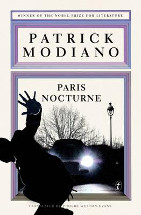Paris Nocturne by Patrick Modiano, trans. by Phoebe Western-Evans

Text, 2015,ISBN 9781925240108
Little Jewel by Patrick Modiano, trans. by Phoebe Western-Evans
Text, 2015, ISBN 9781925240115
(Age: Senior secondary) Patrick Modiano is the winner of the 2014
Nobel Prize for literature. In the reviewed titles his themes of
memory and loss are teased out in the experiences of two young
narrators, the eponymous Little Jewel and the other nameless. The
main characters restlessly traverse the streets of Paris on foot or
by Metro or train; they wait in waiting rooms or bars for hints
about their past and their futures. Key events from their childhoods
are eventually remembered as they follow back and forth significant
threads of thought. The elusive dread that is part of movie director
David Lynch's work is similar to the fear of knowledge and the
questioning of reality that is evoked in these novels. The narrators
experience similar events, the smell of ether, the dog that was lost
in childhood, the shabby overcoats that point to knowledge of the
sinister parent who has in each case disappeared. Little seems
certain in their lives as their thoughts move back and forth in time
and their bodies from place to place. These are city dwellers, and
they list the streets they restlessly walk, but to them landscape
and country places seem critical for identity. Much of the action is
dream-like but is anchored in precise locations, the country towns
from childhood, the apartment rooms that they may have stayed in and
the places they may escape to.
The main character in Little Jewel, nineteen-year-old
Therese, is waiting in the Metro when she sees a woman in a yellow
coat who she feels may be her mother. As she follows the woman who
is obviously impoverished Therese remembers details about her and
their life together. Her mother was an actress and dancer and had
once been in a movie with Therese whom she called Little Jewel. The
career of neither developed and the little girl is abandoned to
friends of her mother. This story is remembered over time when
Therese becomes a companion to a little girl whose parents are cold
and neglectful. When the child wants a dog as a companion the mother
orders Therese to put a stop to this. Therese remembers a dog she
herself had as a child, a dog that her mother callously abandoned.
When Therese nearly faints she is resuscitated with a whiff of ether
which reminds her of a childhood incident when she was taken to nuns
after an accident. The nuns treat her with ether and lots of
kindness. The little girl and her parents who increasingly seem
untrustworthy and cruel disappear and Therese is again abandoned.
Meanwhile she learns that the woman in the yellow coat is her mother
and is known as Death Cheater or the Kraut. Instead of confronting
her Therese turns from the past to the comfort of suicide, but is
saved and in a room of newborns (the hospital has run out of beds)
begins life again, supported by several friends.
Paris Nocturne begins with a minor car crash. The nameless
21-year-old narrator is hit and slightly injured by a 'sea-green
Fiat' driven by a young blonde woman. When they are both taken to
hospital a bond seems to be established, but a heavily built dark
man, Soliere, seems determined that the relationship should not
develop. The smell of ether in the hospital reminds the narrator of
an incident from his past and the reader begins to learn of his
unhappy childhood, when he was raised by an untrustworthy father in
a series of hotel rooms. This culminated in his father calling the
police chief to take the boy, now aged seventeen, away as a
nuisance. This humiliating encounter perhaps resulted in other
memories being suppressed, but Soliere reminds the narrator of his
father and he now remembers meetings in specific cafes. His father
became more dishevelled until finally they no longer met. The
Narrator's memory of specific streets and rooms seems to assure him
of his own reality. He learns the name of the car's driver and
becomes obsessed with finding her. Events like encounters with
Soliere seem sinister and designed to point him away from her, and
the chronology is not always clear as memories are intertwined with
the present. One night the narrator follows a black dog which seems
to be the one he had as a child. The streets seem to become darker
and Soliere more sinister, but when he finds the driver, Jacqueline
Beausergent, her calm and confident manner reassures him and he is
further soothed by her memories of a village near one that he had
stayed in as a child. He seems ready to accept happiness.
In both novels there are the recurring elements of the colour that
provokes memory, the lost dog that symbolises a loss of love and
security, ether that promises safety in loss of memory and escape
and characters that parallel each other in terms of character and
action. Both concern the helplessness and unhappiness of children,
the disconnect between young adults and their social environment and
the nature of memory, in a way that is Proustian. The characters are
restless and rootless as they move through the streets of Paris,
seen here as both seedy and sinister. The language is deceptively
simple but rich in metaphor. The novels are short but reward close
reading and could be used by senior students.
Jenny Hamilton